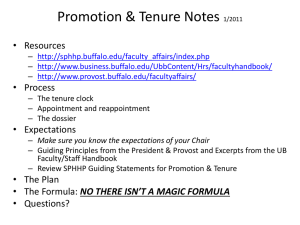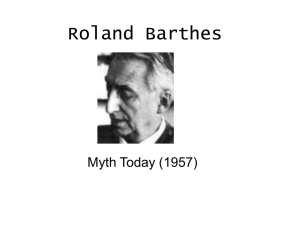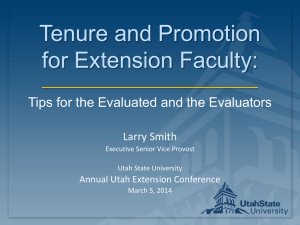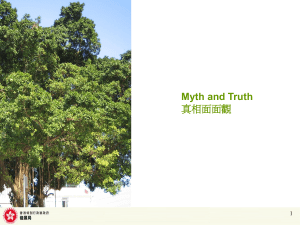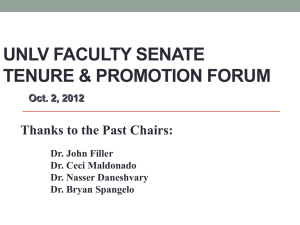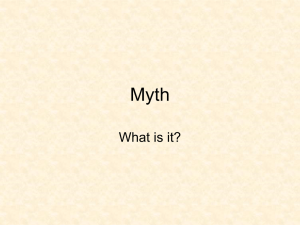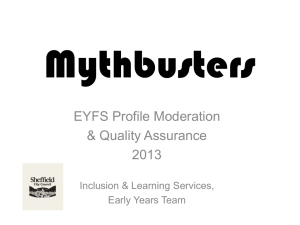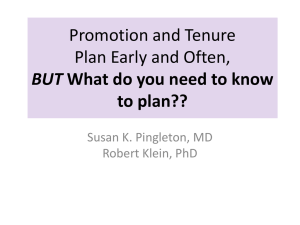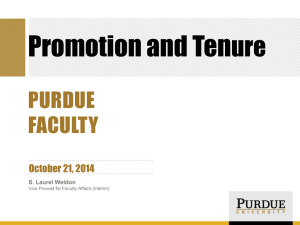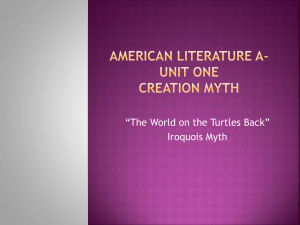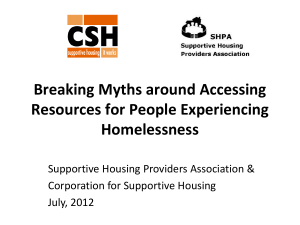RTP-Assistant Professors (.ppt)
advertisement
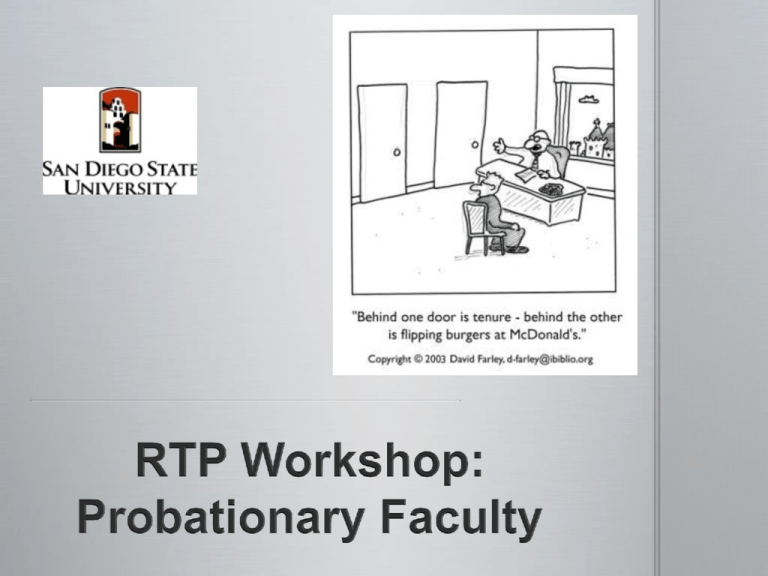
Myth Teaching doesn’t count for tenure and promotion at SDSU. Reality The University Policy File states “the primary qualification for reappointment, tenure, or promotion shall be a demonstration of continuing excellence in teaching.” Peer committees and administrators take evidence of effective teaching very seriously when making their recommendations. Faculty members have been not been reappointed, tenured, or promoted on teaching performance that does not meet the university’s expectations. Myth All reviewers care about are student evaluation scores. Reality Reviewers base their recommendations on a wide range of indicators of teaching effectiveness, including the items you present as well as the course syllabi and majors assignments or exams. Peer reviews, honors and distinctions, curriculum development, use of new technologies, involving students in research or creative activity, and student mentoring and advising are other elements that may be considered (PF 3.1). Student evaluations are required, Numerical scores are important because they are quantifiable and easily compared against department averages. Reviewers also depend heavily upon written comments which can provide a context for the numbers. Myth I had one really difficult class last year, and got lousy student evaluations. Now I’m worried I’ll be penalized in the RTP process. Reality Every faculty member’s evaluations fluctuate somewhat throughout the years. Reviewers consider consistency or improvement across a number of courses and semesters as a measure of overall excellence. You may use your candidate’s statement to provide a context for or explanation of a poor course evaluation. For example, if it was the first time you’ve ever taught that material or the students were unable to get the textbook through no fault of your own, explain that. Myth Only articles in refereed journals count for professional growth. Reality The Policy File states that “Evidence for evaluating professional growth, as identified and defined in department or school and college guidelines, shall comprise: externally reviewed professional growth activities including, as a primary and necessary element, refereed publications of merit, or juried or curated exhibitions and performances” (3.2.) Different disciplines have different expectations on how to satisfy the professional growth criteria. In some, original research must be published in refereed journals for it to reach the appropriate audience; in others, the most recognized form of publication is a scholarly book. And, of course, in the creative and performing arts, publication may not be relevant at all. It’s up to you to provide the best possible information regarding the standards in the field, the quality of the publications, and the method of refereeing (“blind” review is valued most highly), to assist committees in determining the quality of the work. Myth A senior faculty member told me that I should put as much stuff in my one-of-a-kind file as I can. She said that committees count the number of pages, and the more you have the better your chances. Reality Our RTP process emphasizes selectivity and quality, not quantity. You are limited in your Personal Data Summary (PDS) to a threepage personal statement and discussion of no more than five achievements in each of the three major categories of evaluation: teaching effectiveness, professional growth, and service (PF, 7.0). Each discussion is meant to cover one separate achievement not a grouping of, for example, several achievements under the title, “grant applications.” Myth Another colleagues told me I should solicit letters from friends and students and put them in my WPAF. Reality There is no place in the WPAF for testimonials. If there are special circumstances that make your case unusual, you may wish to request an external review of your record. Some colleges or departments require an external review for candidates going up for tenure and/or promotion. Consult with your department chair or the chair of the department peer review committee for information about how to request or initiate an external review. And remember, an external reviewer is an academic professional whose appointment is outside SDSU. Myth My mentor also told me not to let my PDS get stale, to put new items in every year to show my progress. She also said I absolutely must have one example of every type of item. Reality Selecting the five items to illustrate your overall record in the three areas is one of the most important decisions you can make. There is no requirement that you change the items every year but you do want to include recent work to show evidence of continuous professional growth. Take the opportunity each year to update the status of an item: from a concept to a submission to an acceptance to a final publication. Show your breadth within the categories, especially for those types of items most highly valued in your discipline. For example, if you have major journal publications, refereed papers at prestigious conferences, and funded grants, you might want to include an example of each, especially in early probationary years. For service, include one or two university committees, a professional activity, a talk to a community group, etc. Use your common sense: if you have published five articles in the most competitive journals in your field by the time you apply for tenure, you would certainly want to select most or all of these as your five items—especially over a book review or a grant submission that has not been funded. Myth I don’t have a lot of professional growth, but I’ve done a lot of service work for my department. I’ve heard that the Policy File says I can get extra credit for service to make up for my research record. Reality The Policy File says: “When a tenured candidate distinguishes herself or himself in performing such duties to the significant benefit of the university and/or beyond, and when this performance is appropriately documented over a significant time, such service for the university shall have more than the usual bearing on reappointment, tenure, and promotion decisions” (3.3). This exception is applied rarely and only to recognize truly exceptional service carried out by tenured associate professors over a very long period of time. While excellent service is appreciated, it cannot substitute for an inadequate professional growth or teaching record in the case of a probationary faculty member. Myth The standards for tenure are higher for those going up prior to the sixth year. Reality At SDSU, tenure is awarded when the candidate has demonstrated that he or she has met the university’s criteria in teaching effectiveness, professional growth, and service. A strong teaching and publication record as well as service at a level consonant with that expected of an assistant professor may warrant tenure and promotion in, for example, the fourth probationary year. Myth Only work done at SDSU is considered. Reality The Policy File states that “the entire professional record of the candidate shall be considered, including accomplishments prior to appointment at this university” (6.0). It also says that “work developed or sustained while serving at this university shall be essential to the award of tenure and/or promotion.” Work prior to SDSU contributed to your appointment. Everything you have done will appear in your CV and can be discussed in your candidate’s statement. That is the most appropriate place to discuss important work you did prior to appointment at SDSU. The process carefully balances the entire record with evidence of accomplishments while at SDSU. When it comes to selecting the five items, there are no hard and fast rules, only the exercise of good judgment. Just remember that the five items selected are the only items that the committees will be able to review in detail, so they will have substantial input on the committees’ understanding of your work. Myth I didn’t have enough time to work on my one-of-akind file, but it really doesn’t matter, does it? After all, it’s the content that counts. Reality It is very important that your materials be well organized so that reviewers can easily locate documents and have more time to focus on reviewing your materials. If your student evaluations are missing or out of order, they may not be able to assess your teaching effectiveness fully and accurately. The University Panel reviews 60-70 cases in a six-week period, and the Provost may review approximately 150 files. As teachers, we know how much it helps us when our students turn in clear and organized papers and projects. Extend your colleagues the same courtesy. Myth Higher-level recommendations count more than lower-level ones. You don’t have a chance if the Dean, for example, overturns the department’s decision Reality Each recommendation from the department peer review committee to the University Promotions and Tenure Review Panel is independent. Each recommendation and rebuttal will be given full weight. Only the Provost makes a decision. Myth I didn’t get a very good letter from the dean. My best friend at another university told me I should make an appointment to talk to the Provost ahead of time to present my case in a better light. My department chair also volunteered to talk to the Provost if that would help. Reality Each level of review must base its recommendation or decision on what is in the Personnel Action File, which includes the Working Personnel Action File. Nothing outside the file is considered: no gossip, no testimonials, and no conversations with the candidate or anyone else. No peer review committee or administrator should discuss an RTP case with anyone except as required by the Policy File. Under no circumstances would the Provost hold a conversation with anyone about Myth I have positive recommendations from my department and the college committee. I don’t need to submit anything through the late-add process. Reality Again, each recommendation, from the department peer review committee to the University Promotions and Tenure Review Panel is independent and your work may be evaluated differently. If an article you submitted gets accepted, submit the change as a late-add item. Or, if you submit a grant in December, use the late-add process. Fall teaching evaluations, especially if they reflect improvement, can be submitted through the late-add process. In other words, take advantage of the late- add process to strengthen you file.
